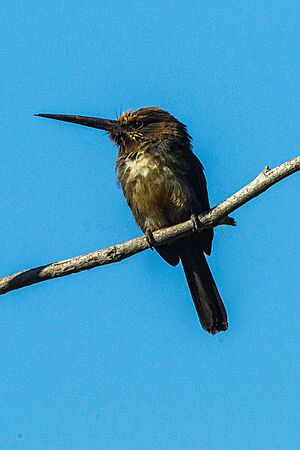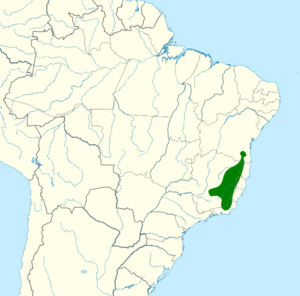Three-toed jacamar facts for kids
Quick facts for kids Three-toed jacamar |
|
|---|---|
 |
|
| Conservation status | |
| Scientific classification | |
 |
|
| Synonyms | |
|
The three-toed jacamar (Jacamaralcyon tridactyla) is a special type of bird found only in Brazil. It belongs to the Galbulidae family, which includes other jacamars. This bird lives in warm, wet forests and even in some farms. Sadly, its home is shrinking, which puts the three-toed jacamar at risk.
Contents
About the Three-Toed Jacamar
The three-toed jacamar is one of 18 different jacamar species. It is the only bird in its group, called Jacamaralcyon. This means it's quite unique!
When this bird was first described in 1807, a French scientist named François Levaillant called it "jacamaralcion." This name mixes "jacamar" with "alcyon," which means "kingfisher." Later, in 1817, another French scientist, Louis Pierre Vieillot, gave it the scientific name Galbula tridactyla.
In 1830, a scientist named René Primevère Lesson created the special group Jacamaralcyon just for this bird. He did this because of its unusual feet. The name tridactyla comes from two Greek words: tri, meaning "three," and dactulos, meaning "toes." This perfectly describes its unique feet!
What Does This Bird Look Like?
Like all jacamars, the three-toed jacamar has short legs and short wings. It sits upright, with its tail pointing down and its long, sharp beak pointing up.
This is a medium-sized bird. It is about 18 cm (7.1 in) long. It weighs between 17.4 and 19.3 g (0.61 and 0.68 oz), which is about as much as a few quarters. Female jacamars are usually a bit heavier than males.
Both male and female birds look very similar. They are dark gray-black on top with a shiny bronze-green color. Their undersides are a bit lighter, with white on their belly and the middle of their chest. Adults have a brownish-gray cap on their head and a black throat. Their head and chin have fine, pale streaks. Their beak is black, and their feet are gray.
One very special thing about the three-toed jacamar is its feet. Unlike other jacamars, which have four toes, this bird has only three! It is missing a back toe, and its front two toes are joined together at the bottom.
Where Does the Jacamar Live?
The three-toed jacamar lives only in southeastern Brazil. It prefers the drier parts of the Atlantic Forest. Today, you can mostly find it in the states of Rio de Janeiro and eastern Minas Gerais. In the past, it also lived in other states like Espírito Santo, São Paulo, and Paraná.
Even though it usually lives in untouched forests, this bird can also survive in areas that have been changed by humans, like farms. But it needs some native plants to still be there. It also seems to like living near streams because it needs dirt banks to build its nests. It can even use banks created by road cuts. These birds usually stay in one place, but young birds will fly off to find new homes, and adults sometimes move short distances.
Jacamar Behavior and Habits
Even though three-toed jacamars nest in groups, you usually see them alone or in pairs. Sometimes, they will join groups of other bird species.
What Do Jacamars Eat?
Like all jacamars, the three-toed jacamar eats insects. It especially likes small, camouflaged moths and butterflies, and bees and wasps. But it also eats flies, dragonflies, beetles, true bugs, and termites.
It hunts from an open branch in the forest. When it sees an insect, it quickly flies out to catch it. The bird often hits its prey against a branch. This helps to stun the insect and remove any stingers, venom, or wings.
Reproduction and Nesting
Three-toed jacamars breed during Brazil's rainy season, which is from September to February. During this time, you can hear them singing more, and they show off to each other. When males are competing, they sit side by side on a branch, flapping their wings and pumping their tails as they sing. They use their songs to protect their territory and rarely fight physically.
These birds dig a burrow nest in a dirt bank. They use one foot at a time to dig. It seems that the female bird does most, or even all, of the digging. Their burrows are about 6 cm (2.4 in) wide and 6–9 cm (2.4–3.5 in) high. They can go as deep as 72 cm (28 in) into the bank. These birds like to nest in groups. The female usually lays 2–4 eggs.
Jacamar Calls and Songs
The three-toed jacamar's song is a loud series of short, rising whistles. It lasts about 20 seconds. Unlike most jacamars, which sing alone, male three-toed jacamars often sing in groups of 2 to 6 birds.
Protecting the Three-Toed Jacamar
The three-toed jacamar is a bird that needs our help. Losing its home and its habitat becoming damaged has caused its numbers to drop a lot. Because of this, the International Union for Conservation of Nature has listed it as Near Threatened.
Scientists believe there are only about 350–1500 of these birds left. They live in small, spread-out areas of suitable habitat across southeastern Brazil. Protecting their forest homes is very important for their survival.


